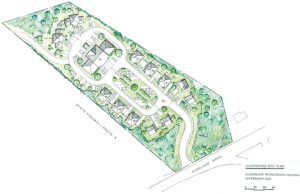TRURO — The proposed affordable housing complex known as the “Cloverleaf” will have the cedar shingles and painted trim that have typified other housing developments by the Provincetown-based Community Housing Resource (CHR).
Ted Malone, president of CHR, designed the Sally’s Way complex behind the Truro Public Library, as well as Stable Path, off Race Point Road in Provincetown. The design of Malone’s latest proposal was reviewed on June 25, when the zoning board of appeals reopened its public hearing on the permitting of the Cloverleaf, which will include 11 buildings on 3.9 acres of land acquired at no cost from the state at 22 Highland Road in North Truro.
Due to the coronavirus, the ZBA had taken a long hiatus, but last Thursday the board was back in action, with town planner Jeffrey Ribeiro explaining his assessment of the Cloverleaf’s design and size.
The plan now comprises 39 rental units, down from the original 40, due to reconfiguration of the entrance as required by the fire dept.
Among the 11 buildings in the project, the largest, located at its center with 15 apartments, has generated the most questions, said Ribeiro.

He compared it to familiar local buildings: the front is about 29 feet tall, the same as Truro Vineyard’s main structure. The rear of the apartment building is about 39 feet tall, the height of the former town-owned Grace Gouveia Building on Provincetown’s Cemetery Road. The proposed building is 20 feet longer than the Grace Gouveia or the Vineyard building, Ribeiro said.
Truro’s planner also conducted a “balloon test,” that is, he flew a balloon to the proposed height of the structures and took pictures from different viewpoints, including Route 6. The balloon did show above existing trees, but just barely.
“You can see — the relative height is still within the tree line, so even if the tree line is thinned, it won’t be sticking out like a skyscraper on the horizon,” Ribeiro said.
The statements of opponents during this virtual hearing were much less heated than in December, when Peter Herridge, a member of the planning board, warned that such dense development could cause water quality at nearby Pond Village to plummet in an area that already has the lowest water quality in Truro. A fact check of his statements, however, found some to be untrue. He said that nitrogen levels in some private wells in Pond Village are over 10 mg (the maximum allowed). Both Truro Health Agent Emily Beebe and board of health chair Tracey Rose told the Independent they were unaware of any tests over 5 mg.
Nonetheless, the ZBA required the project to have a more rigorous septage treatment system, which was designed by engineer J.M. O’Reilly & Associates. The new design added a layer of treatment beyond a traditional Title 5 system, Ribeiro said. The Horsley Witten Group, which was hired to do an independent review of O’Reilly’s design, will present its findings at the next meeting, scheduled for July 9.
Other objections came from Chuck Steinman, of Shore Road, who argued in a letter that the coronavirus is a “game changer” for congregate housing for seniors, and that a building with 15 individual units and common spaces may not be safe or marketable.
To this, Andrea Aldana, director of housing advocacy for the Eastham-based Community Development Partnership, said his concern “is not founded in fact.”
“Solid affordable housing stock reduces overcrowding and makes public safety less of an issue,” Aldana said. “Density is not linked to Covid-19.”
The ZBA has two more meetings scheduled, the last on July 13, at which the board may approve the project. That would give the developer time to apply for state financing in August. If that happens, groundbreaking could begin as soon as June 2021, Malone said. But if permitting takes longer and funding must wait until 2021, it will be February 2022 when the first shovel hits the ground, Malone said.
Ribeiro said Chapter 40B of the state’s zoning laws, which allows for waivers that make projects like this possible, is not just about affordable housing but civil rights: laws governing land use may effectively keep out people of certain income levels.
“We always talk about inclusionary zoning, but there is exclusionary zoning that keeps people out of a community,” Ribeiro said.
There are currently 687 employees working in Truro who earn an average weekly wage of $822, Ribeiro said. Without affordable housing, workers at that income level are prevented from living in Truro.



